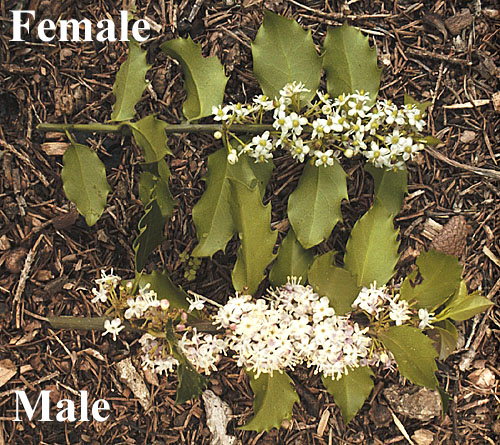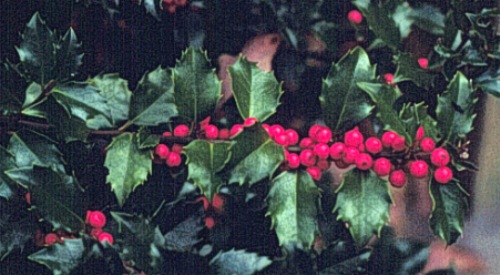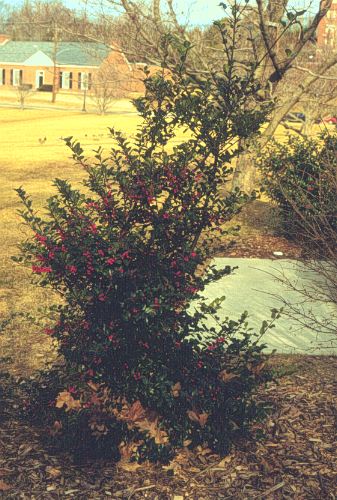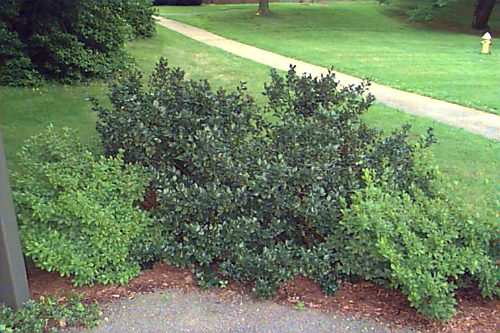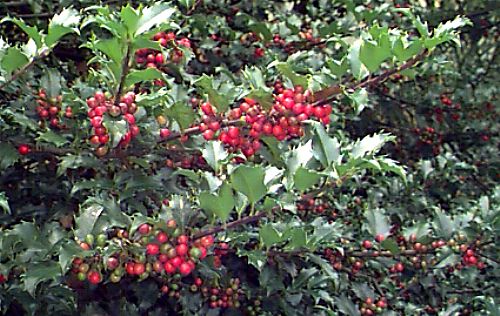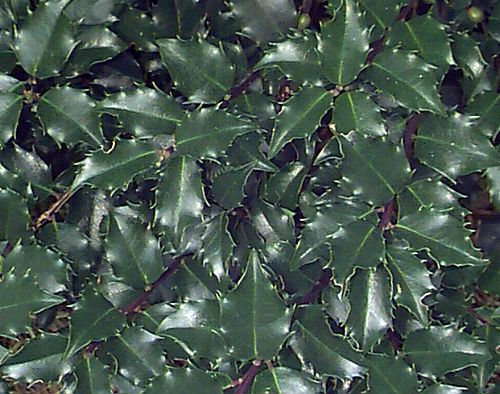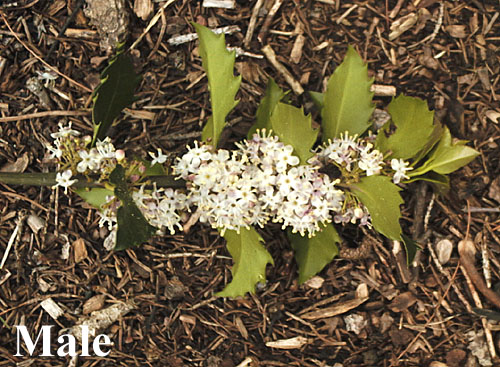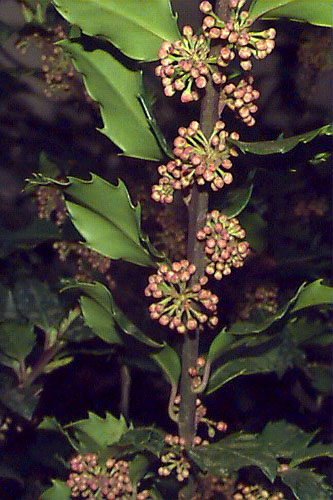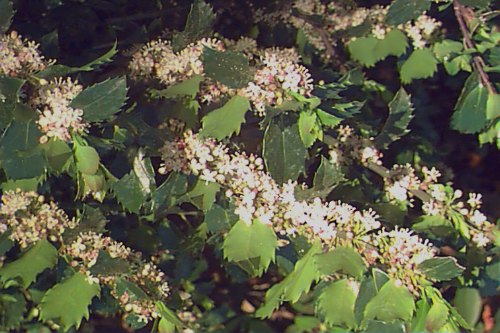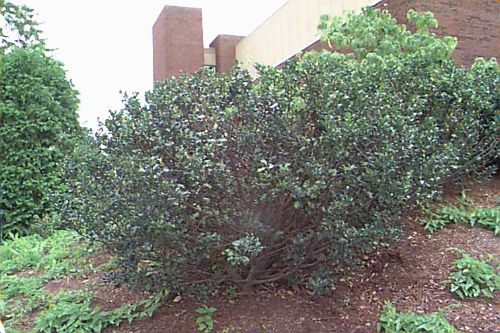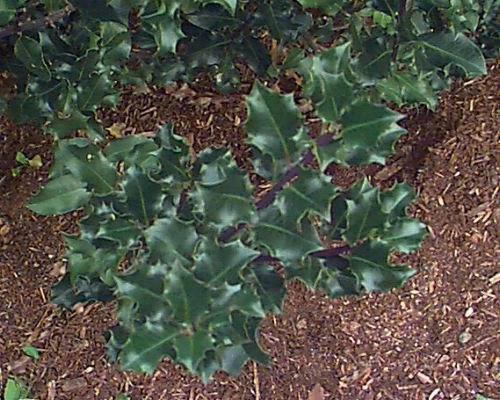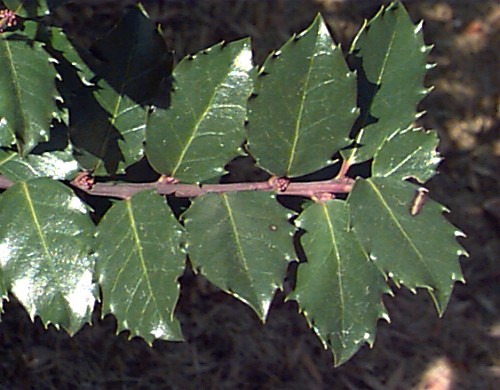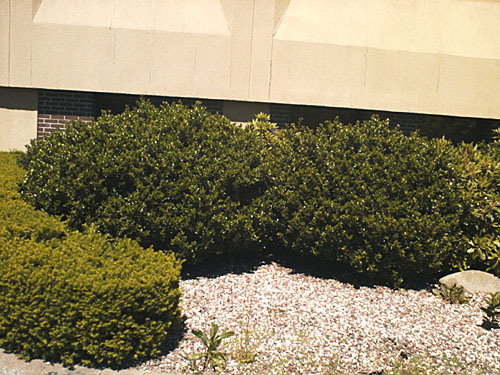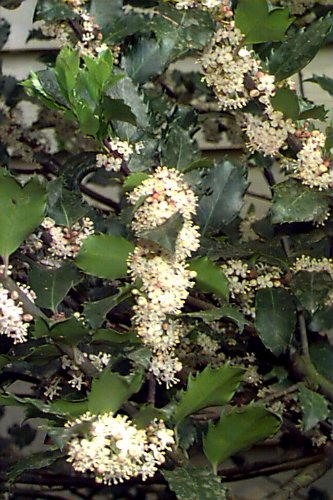Ilex x meserveae
Meserve Hybrid Holly
Aquifoliaceae
ExpandHabitat
- hybrids between I. rugosa and I. aquifolium or I. cornuta and I. rugosa
- the intent was to develop cold hardy evergreen hollies with shiny, high quality, evergreen foliage by crossing a species with good cold hardiness but inferior foliage with a species possessing poor cold hardiness, but excellent foliage
- Mrs. F. Leighton Meserve of St. James, NY produced the initial hybrids and they were introduced by Conard-Pyle Nurseries
- zone 5; probably in most locations in zone 4 as well
Habit and Form
- can grow up to 12' or even 15' tall, but most plants reach a mature height of 8'
- form varies with the cultivar, but is either pyramidal or rounded
- branching is horizontal to irregular
- generally dense and shrubby
Summer Foliage
- leaves evergreen
- very dark almost blue-green
- glossy
- margins with rather closely spaced teeth/spines
- 1.5" to 2.25" long
- 1 to 1.5" wide
- stems are bluish purple with green
Autumn Foliage
- evergreen, so no fall color
- foliage turns slightly purple in the winter
Flowers
- dioecious, with male and female plants
- small white flowers in late April and early May
- flowers are numerous, but not overwhelmingly ornamental
- male plants are slightly showier in bloom
Fruit
- only produced by female plants
- bright red shiny fruit about 0.33" in diameter
- matures to red in the fall
- can be quite showy
- a male pollinator is needed nearby for peak fruit set (within about 300 feet)
Bark
- green, except brown on only the very oldest wood
- generally hidden by the foliage
Culture
- grows best in full sun, but light shade is toleranted with more open growth resulting
- prefers moist, slightly acidic, well-drained soils, but it is relatively soil adaptable
- can be pruned to remove straying branches, but wholesale pruning is not necessary.
- although quite cold hardy, avoid very exposed windswept locations
- relatively carefree plant
Landscape Use
- foundation plant
- hedges
- barriers
- mass plantings
- useful for high quality evergreen foliage
- for fruiting effect in fall and winter
- fruits attract robins, bluebirds, catbirds, and mockingbirds
Liabilities
- need female plants and a nearby pollinator for peak fruit set
- winter burn or injury can result in difficult winters or when one fails to use the most cold hardy cultivars
ID Features
- shrubby habit
- dark blue-green shiny leaves
- closely-spaced teeth/spines on leaves
- purplish new stems
- red fruit (female plants only)
Propagation
- exclusively by cuttings
Cultivars/Varieties
The following are I. rugosa x I. aquifolium hybrids, referred to as Blue Hollies:
'Blue Angel' (Blue Angel®) - This slow-growing cultivar is the least cold hardy of the group. It is the result of a backcross of I. x meserveae to I. aquifolium. As a consequence, the plant has larger, crinkled leaves and reduced cold hardiness from the added I. aquifolium influence. It is a female selection with shiny red fruits and grows full and dense to 8' tall and wide.
'Blue Boy' - Introduced in 1964 as one of the first Meserve Hollies, this male form is a fairly good performer. It grows well over 10' tall and has good quality lustrous green foliage.
'Blue Girl' - This is the female counterpart to 'Blue Boy' with bright red fruit. It was one of the original Meserve Holly introductions in 1964. It offers good cold hardiness, but seems to grow a bit more open than 'Blue Princess'. The overall habit is pyramidal to around 8' tall.
'Mesid' (Blue Maid®) - A hardy, fast growing female selection, this plant assumes a pyramidal habit to 15' tall. It offers abundant bright red fruit. Though this plant has been touted as being the most cold hardy form, both 'Blue Princess and 'Blue Girl' appear to stand up to cold just as well.
'Blue Prince' (Blue Prince®) - This male selection was introduced in 1972. It has an excellent dense, compact habit to 12' tall with good quality, dark shiny green foliage. It is considered both an excellent pollinator for Meserve Hollies and a handsome, easily-pruned landscape plant. The plant has proven cold hardiness down to -20 degrees F. and is the most popular male selection of this group.
'Blue Princess' - The most popular female selection, this plant was introduced in 1973. It offers very dark blue-green foliage that is shiny. The fruit color is a darker red than many others and the drupes are abundantly produced. Cold hardiness is reliable to the -15 to -20 degrees F range. The habit is broad and shrubby to 15' tall. Some feel this is the best of the group.
'Honey Maid' and 'Gretchen' - These new female forms are variegated sports grown primarily for their leaves which are splotched and margined with yellow. They grow smaller (to 6' tall) and form red fruits. The hardiness of these plants allows growers in colder regions to enjoy an evergreen variegated holly.
'Mesan' (Blue Stallion®) - A male selection with a long blooming period, this form serves as an effective pollinator. It grows more rapidly than 'Blue Prince' (Blue Prince®) (to 12' tall and wide). The foliage -- borne on attractive purplish stems -- lacks prominent spines and is a dark, shiny green.
The following are I. cornuta x I. rugosa hybrids:
'Mesdob' (China Boy®) - Reportedly cold hardy to -20 degrees F., this male selection is useful as a pollinator for 'Mesog' (China Girl®). The foliage is glossy green and the plants grow to about 10' tall with similar spread. The habit is rounded and dense in the landscape. The "China Series" appears to be both more heat and cold tolerant than the I. rugosa x I. aquifolium hybrids (Blue Hollies).
'Mesog' (China Girl®) - This is a female clone that is pollinated by 'Mesdob' (China Boy®) and features abundant 1/3" red fruit on a 10' tall and wide shrub. It has been embraced as an excellent landscape plant and displays better heat tolerance than the Blue hybrids. The leaf margins of this selection and its male counterpart turn under, leading to a "cupping" effect that separates these plants visually from the Blue hybrids.
Other Meserve Hybrids:
'Meschick' (Dragon Lady®) - This hybrid of I. pernyi x I. aquifolium is useful as a screen or hedge because of its strong pyramidal-columnar habit to 20' tall with a 6' spread. The leaves are spiny and dark green, while red fruit are produced using 'Mesan' (Blue Stallion®) as a pollinator.
'Mesgolg' (Golden Girl®) - This plant is notable as the first Meserve hybrid with yellow-orange fruit. It has a broad pyramidal habit and a dense complement of foliage.
